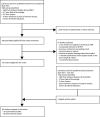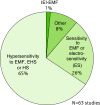Idiopathic environmental intolerance attributed to electromagnetic fields (IEI-EMF): a systematic review of identifying criteria
- PMID: 22883305
- PMCID: PMC3504528
- DOI: 10.1186/1471-2458-12-643
Idiopathic environmental intolerance attributed to electromagnetic fields (IEI-EMF): a systematic review of identifying criteria
Abstract
Background: Idiopathic environmental intolerance attributed to electromagnetic fields (IEI-EMF) remains a complex and unclear phenomenon, often characterized by the report of various, non-specific physical symptoms (NSPS) when an EMF source is present or perceived by the individual. The lack of validated criteria for defining and assessing IEI-EMF affects the quality of the relevant research, hindering not only the comparison or integration of study findings, but also the identification and management of patients by health care providers. The objective of this review was to evaluate and summarize the criteria that previous studies employed to identify IEI-EMF participants.
Methods: An extensive literature search was performed for studies published up to June 2011. We searched EMBASE, Medline, Psychinfo, Scopus and Web of Science. Additionally, citation analyses were performed for key papers, reference sections of relevant papers were searched, conference proceedings were examined and a literature database held by the Mobile Phones Research Unit of King's College London was reviewed.
Results: Sixty-three studies were included. "Hypersensitivity to EMF" was the most frequently used descriptive term. Despite heterogeneity, the criteria predominantly used to identify IEI-EMF individuals were: 1. Self-report of being (hyper)sensitive to EMF. 2. Attribution of NSPS to at least one EMF source. 3. Absence of medical or psychiatric/psychological disorder capable of accounting for these symptoms 4. Symptoms should occur soon (up to 24 hours) after the individual perceives an exposure source or exposed area. (Hyper)sensitivity to EMF was either generalized (attribution to various EMF sources) or source-specific. Experimental studies used a larger number of criteria than those of observational design and performed more frequently a medical examination or interview as prerequisite for inclusion.
Conclusions: Considerable heterogeneity exists in the criteria used by the researchers to identify IEI-EMF, due to explicit differences in their conceptual frameworks. Further work is required to produce consensus criteria not only for research purposes but also for use in clinical practice. This could be achieved by the development of an international protocol enabling a clearly defined case definition for IEI-EMF and a validated screening tool, with active involvement of medical practitioners.
Figures



Similar articles
-
Eliciting adverse effects data from participants in clinical trials.Cochrane Database Syst Rev. 2018 Jan 16;1(1):MR000039. doi: 10.1002/14651858.MR000039.pub2. Cochrane Database Syst Rev. 2018. PMID: 29372930 Free PMC article.
-
Systemic pharmacological treatments for chronic plaque psoriasis: a network meta-analysis.Cochrane Database Syst Rev. 2021 Apr 19;4(4):CD011535. doi: 10.1002/14651858.CD011535.pub4. Cochrane Database Syst Rev. 2021. Update in: Cochrane Database Syst Rev. 2022 May 23;5:CD011535. doi: 10.1002/14651858.CD011535.pub5. PMID: 33871055 Free PMC article. Updated.
-
Behavioral interventions to reduce risk for sexual transmission of HIV among men who have sex with men.Cochrane Database Syst Rev. 2008 Jul 16;(3):CD001230. doi: 10.1002/14651858.CD001230.pub2. Cochrane Database Syst Rev. 2008. PMID: 18646068
-
Home treatment for mental health problems: a systematic review.Health Technol Assess. 2001;5(15):1-139. doi: 10.3310/hta5150. Health Technol Assess. 2001. PMID: 11532236
-
Signs and symptoms to determine if a patient presenting in primary care or hospital outpatient settings has COVID-19.Cochrane Database Syst Rev. 2022 May 20;5(5):CD013665. doi: 10.1002/14651858.CD013665.pub3. Cochrane Database Syst Rev. 2022. PMID: 35593186 Free PMC article.
Cited by
-
The effects of radiofrequency electromagnetic fields exposure on tinnitus, migraine and non-specific symptoms in the general and working population: A protocol for a systematic review on human observational studies.Environ Int. 2021 Dec;157:106852. doi: 10.1016/j.envint.2021.106852. Epub 2021 Sep 6. Environ Int. 2021. PMID: 34500362 Free PMC article.
-
An idiographic approach to idiopathic environmental intolerance attributed to electromagnetic fields (IEI-EMF) part I. Environmental, psychosocial and clinical assessment of three individuals with severe IEI-EMF.Heliyon. 2022 Jul 16;8(7):e09987. doi: 10.1016/j.heliyon.2022.e09987. eCollection 2022 Jul. Heliyon. 2022. PMID: 35874058 Free PMC article.
-
Prevalence and correlation of multiple chemical sensitivity and electromagnetic hypersensitivity with age, sex, and depression in the Japanese population: a retrospective study.BMC Public Health. 2023 Jun 21;23(1):1205. doi: 10.1186/s12889-023-16152-2. BMC Public Health. 2023. PMID: 37344806 Free PMC article.
-
The effects of radiofrequency electromagnetic fields exposure on human self-reported symptoms: A protocol for a systematic review of human experimental studies.Environ Int. 2022 Jan;158:106953. doi: 10.1016/j.envint.2021.106953. Epub 2021 Nov 1. Environ Int. 2022. PMID: 34735955 Free PMC article.
-
Methodological limitations in experimental studies on symptom development in individuals with idiopathic environmental intolerance attributed to electromagnetic fields (IEI-EMF) - a systematic review.Environ Health. 2019 Oct 22;18(1):88. doi: 10.1186/s12940-019-0519-x. Environ Health. 2019. PMID: 31640707 Free PMC article.
References
-
- Randolph TG. Human ecology and susceptibility to the chemical environment. Springfield (IL): Charles Thomas; 1962.
-
- WHO. Fact Sheet No. 296: Electromagnetic fields and public health. World Health Organization; 2005. http://www.emfandhealth.com/WHO_EMSensitivity.pdf.
Publication types
MeSH terms
LinkOut - more resources
Full Text Sources
Medical

